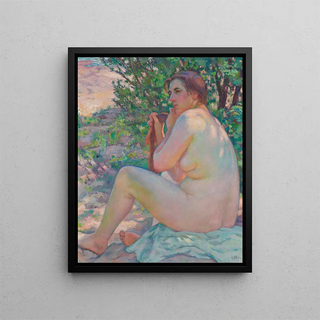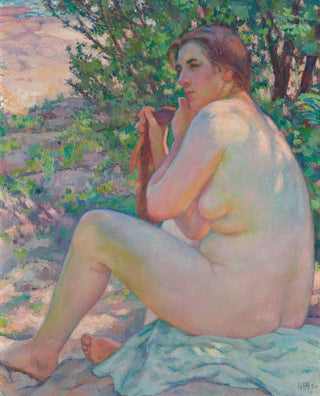Art print | In the shade of the bush - Theo van Rysselberghe


View from behind

Frame (optional)
At the Shadow of the Bush - Theo van Rysselberghe – Captivating Introduction
Within the vast panorama of Belgian art, the artwork "At the Shadow of the Bush" by Theo van Rysselberghe stands out for its delicate atmosphere and subtle nuances. This piece, emblematic of the neo-impressionist movement, invites the viewer to immerse themselves in a moment of serenity, where nature and humanity meet in perfect harmony. Light plays a crucial role in this composition, revealing the artist's technical mastery. Through this art print, one can appreciate the finesse of each brushstroke, which seems to capture not only the beauty of the landscape but also the very essence of the life surrounding it.
Style and uniqueness of the artwork
The piece is characterized by a vibrant color palette and a pointillist technique that brings the depicted elements to life. The paint strokes, applied with precision, create a texture that evokes the filtered light through the foliage. The composition is carefully balanced, highlighting a lush bush that provides a protective shadow. This play of shadow and light, so dear to Van Rysselberghe, emphasizes the ephemeral beauty of moments spent outdoors. The eye is naturally drawn to the depth of the scene, where one senses a peaceful life, as if suspended in time. This painting is an ode to nature, a celebration of moments of contemplation that can be experienced in the heart of a garden.
The artist and his influence
Theo van Rysselberghe, an essential figure of the Belgian artistic movement of the late 19th century, managed to blend tradition and innovation. Influenced by Impressionist masters and the color theories of his time, he developed a unique style distinguished by its scientific approach to light. His contribution to neo-impressionism was decisive, not only through his works but also through his role as a mentor to many emerging artists. By incorporating elements of daily life and exploring the interactions between man and nature, Van Rysselberghe paved the way for a new way of perceiving art, where sensitivity and emotion take precedence over mere representation. His legacy endures, inspiring

Matte finish

View from behind

Frame (optional)
At the Shadow of the Bush - Theo van Rysselberghe – Captivating Introduction
Within the vast panorama of Belgian art, the artwork "At the Shadow of the Bush" by Theo van Rysselberghe stands out for its delicate atmosphere and subtle nuances. This piece, emblematic of the neo-impressionist movement, invites the viewer to immerse themselves in a moment of serenity, where nature and humanity meet in perfect harmony. Light plays a crucial role in this composition, revealing the artist's technical mastery. Through this art print, one can appreciate the finesse of each brushstroke, which seems to capture not only the beauty of the landscape but also the very essence of the life surrounding it.
Style and uniqueness of the artwork
The piece is characterized by a vibrant color palette and a pointillist technique that brings the depicted elements to life. The paint strokes, applied with precision, create a texture that evokes the filtered light through the foliage. The composition is carefully balanced, highlighting a lush bush that provides a protective shadow. This play of shadow and light, so dear to Van Rysselberghe, emphasizes the ephemeral beauty of moments spent outdoors. The eye is naturally drawn to the depth of the scene, where one senses a peaceful life, as if suspended in time. This painting is an ode to nature, a celebration of moments of contemplation that can be experienced in the heart of a garden.
The artist and his influence
Theo van Rysselberghe, an essential figure of the Belgian artistic movement of the late 19th century, managed to blend tradition and innovation. Influenced by Impressionist masters and the color theories of his time, he developed a unique style distinguished by its scientific approach to light. His contribution to neo-impressionism was decisive, not only through his works but also through his role as a mentor to many emerging artists. By incorporating elements of daily life and exploring the interactions between man and nature, Van Rysselberghe paved the way for a new way of perceiving art, where sensitivity and emotion take precedence over mere representation. His legacy endures, inspiring






